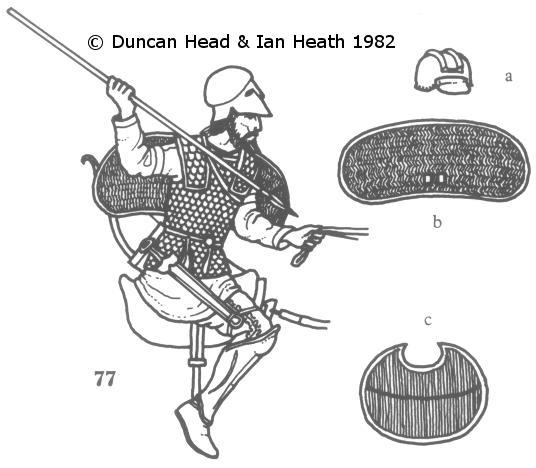
|
Try Amazon Audible Plus Join Amazon Prime - Watch Thousands of Movies & TV Shows Anytime - Start Free Trial Now |
SCYTHIAN NOBLE
An extract from Armies of the Macedonian and Punic Warsby Duncan Head, illustrated by Ian Heath
77. SCYTHIAN NOBLE

|
Try Amazon Audible Plus Join Amazon Prime - Watch Thousands of Movies & TV Shows Anytime - Start Free Trial Now |
This man is based on the central figure of the 4th-century gold Solokha comb. Such heavy equipment, like that found in princely graves, may have become commoner under the influence of the armoured Sarmatians. Certainly in 310 the Crimean Scythians had a body of picked cavalry well enough equipped to charge straight through a Sarmatian army. This figure wears normal Scythian dress plus Greek greaves, old-fashioned Corinthian helmet and a scaled corselet. 77a shows another Greek bronze helmet, an "Illyrian" type (figure 74) with the characteristic double crest ridge of that type. It has been cut down and had a peak riveted on. It was found in the Crimea along with a fragment of bronze scales on a leather backing, no doubt from a cuirass, and another armour fragment of thin bronze strips on leather, like much later "splinted" arm and leg defences. Other scale armour was iron; one iron cuirass was decorated with copper scales at shoulders and the lower edge. This manís cuirass has shoulder-pieces but not pteruges. Greek bronze plate was occasionally used.
Weapons are bow and javelins, and a short sword has also been shown. He has a wicker shield slung on his back; 77b shows the shape, 77c is a similar shield of pelte shape, carried by a second cuirassed figure on the comb, who since he stands by a fallen horse is probably a dismounted cavalryman. In earlier centuries small round shields faced with iron or gold were used, but they seem to have fallen out of favour.